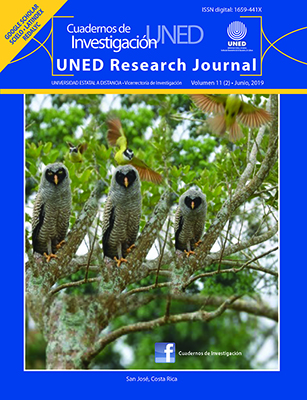Use of an “app” as an arrangement learning support tool in the Computing Logic Course of the Distance State University
DOI:
https://doi.org/10.22458/urj.v11i2.2297Keywords:
information technology, distance education, computer app, mobile phone, educational computingAbstract
Introduction: e-learning is growing around the world exponentially and locally adapted applications or “apps” are useful. Objective: to learn if low performing students in a course about unidimensional and multidimensional structures would be motivated to learn with the help of an app. Methods: we applied a survey to students of Computing Logic who used the app. Results: each student prefers didactical materials which can be used within their mobile dispositive and rated the app positively. Conclusions: the app must have video tutorials, solved exercises, readings and podcasts, as well as a section to set daily goals that can motive students. Furthermore, they want to be able to choose learning options that produce the same final result; and both students and teachers need to get involved with the app.
References
Alberta Education. (2012). Programs of study. Recuperado de https://education.alberta.ca/programs-of-study/programs-of-study/?searchMode=3
Arain, A., Hussain, Z., Rizvi, W., & Vighio, M. (2017). An analysis of the influence of a mobile learning aplicaciónlication on the learning outcomes of higher education students. Universal Access in the Information Society, 17(2), 325-334.
Ayub, A., Zaini, S., Luan, W., & Jaafar, W. (2017). The Influence of Mobile Self-efficacy, Personal Innovativeness and Readiness towards Students’ Attitudes towards the use of Mobile Aplicaciones in Learning and Teaching. International Journal of Academic Research in Business and Social Sciences, 7(14), 364-374. DOI: 10.6007/IJARBSS/v7-i14/3673
Castaño, C., & Cabero, J. (Coords). (2013). Enseñar y aprender en entornos M-Learning. Madrid: Editorial Síntesis.
Chen, B., & Denoyelles, A. (2013). Exploring students’ mobile learning practices in higher education. Educause Review, 7. Recuperado de https://er.educause.edu/articles/2013/10/exploring-students-mobile-learning-practices-in-higher-education
Creative Research Systems. (2006). The Survey System del Creative Research Systems. California, U.S.A. Recuperado de http://www.surveysoftware.net/sscalce.htm
De Witt, C., & Gloerfeld, C. (2017). Mobile Learning and Higher Education. In D. Kergel, B. Heidkamp, P. Telléus, T. Rachwal, & S. Nowakowski (Eds.), The Digital Turn in Higher Education (pp. 61-79). Wiesbaden, Germany: Springer VS.
Figueras-Maz, M., Ferrés, J., & Mateus, J. (2018). Percepción de los/as coordinadores/as de la innovación docente en las universidades españolas sobre el uso de dispositivos móviles en el aula. Revista Prisma Social, 20, 160-179.
García, L., Ruiz, M., & Domínguez, D. (2007). De la educación a distancia a la educación virtual (1a ed.). Barcelona, España: Ariel.
Hernández, R., Fernández, C., & Baptista, P. (2006). Metodología de la investigación (4a ed.). México: McGraw-Hill Interamericana.
Palmero, F. (2011). Metodología de solución de problemas. Recuperado de http://aprendizajealgoritmos.blogspot.com/2011/02/metodologia-de-solucion-de-problemas_16.html
Pechenkina, E. (2017). Developing a typology of mobile aplicaciones in higher education: A national case-study. Australasian Journal of Educational Technology, 33(4), 134-146.
Pechenkina, E., Laurence, D., Oates, G., Eldridge, D., & Hunter, D. (2017). Using a gamified mobile aplicación to increase student engagement, retention and academic achievement. International Journal of Educational Technology in Higher Education, 14(31), 1-12. DOI: 10.1186/s41239-017-0069-7
Salas, I. (2016). Modelo de enseñanza y formación en línea. En A. C. Umaña Mata, I. Salas Campos, & V. Berrocal Carvajal (Eds.), Consideraciones para el diseño y oferta de asignaturas en línea (25-33). San José, Costa Rica: UNED.
SUTEL. (2018). Mapas de calidad SUTEL. Recuperado de https://mapas.sutel.go.cr/
UNED. (2012). Plan de desarrollo académico 2012-2017. Recuperado de https://www.uned.ac.cr/academica/plan_academico/insumos/PlanDesAcad_UNED_fin al.pdf
UNESCO. (s.f.). El aprendizaje móvil. Recuperado de http://www.unesco.org/new/es/unesco/themes/icts/m4ed/
Vázquez, E., & Sevillano, M. (2018). Sustainable Mobility in Higher Education Through Virtual Attendance. In U. Azeiteiro, W. Leal Filho, & L. Aires (Eds.), Climate Literacy and Innovations in Climate Change Education (pp. 341-357). Cham: Springer. DOI: 10.1007/978-3-319-70199-8_20
Zhou, M., Mintz, Y., Fukuoka, Y., Goldberg, K., Flowers, E., Kaminsky, P., … Aswani, A. (2018). Personalizing Mobile Fitness Aplicaciones using Reinforcement Learning. Recuperado de http://ceur-ws.org/Vol-2068/humanize7.pdf
Additional Files
Published
How to Cite
Issue
Section
License
Note: This abstract contains an incorrect copyright due to technical issues. Authors who publish with this journal agree to the following terms: Authors retain copyright and grant the journal right of first publication with the work simultaneously licensed under a Creative Commons Attribution License that allows others to share the work with an acknowledgement of the work's authorship and initial publication in this journal
All journal contents are freely available through a CC BY 4.0 license.
CC BY 4.0 is a Creative Commons: you can copy, modify, distribute, and perform, even for commercial reasons, without asking permission, if you give appropriate credit.
Contents can be reproduced if the source and copyright are acknowledged according to the Open Access license CC BY 4.0. Self-storage in preprint servers and repositories is allowed for all versions. We encourage authors to publish raw data and data logs in public repositories and to include the links with all drafts so that reviewers and readers can consult them at any time.
The journal is financed by public funds via Universidad Estatal a Distancia and editorial independence and ethical compliance are guaranteed by the Board of Editors, UNED. We do not publish paid ads or receive funds from companies.
